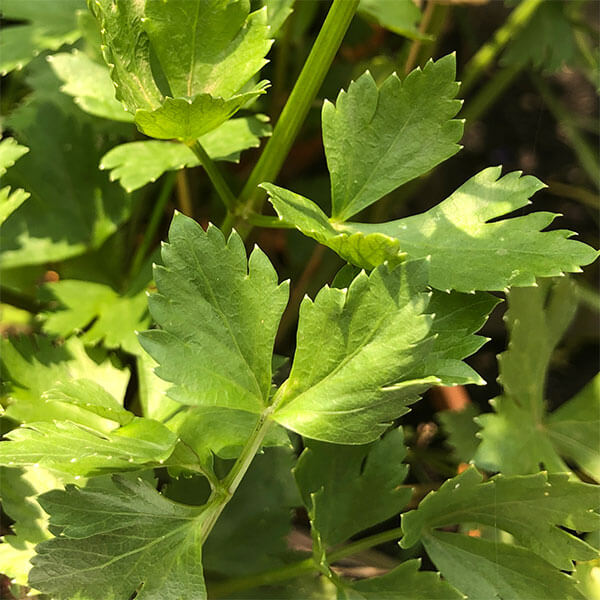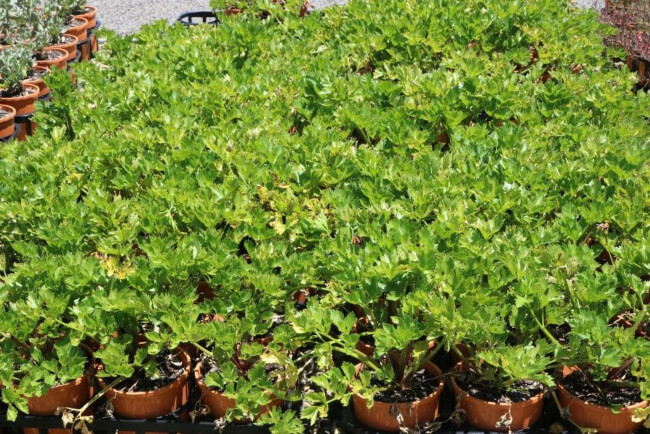Sea celery is a capable coastal species that is commonly used as a native herb or vegetable that can add a lovely flavour to a variety of dishes. This popular bush tucker looks, smells and tastes very similar to conventional celery but sports delightful hints of the ocean in its flavour profile to boot.
I believe that this species is a must-have for those who have or want a useful veggie garden so in this article, I will be explaining how you can grow and care for this celebrated native plant in your garden.
More...

Source: Nurseries Online
Family: | Apiaceae |
|---|---|
Genus: | Apium |
Species: | A. annuum |
Common Names: | Sea celery, annual celery |
Origin: | Australian Native |
Location: | Outdoor |
Type: | Annual or biennial herb/vegetable (edible) |
Growth: | 30 cm to 50 cm tall and wide |
Sun requirements: | Full sun to part shade |
Foliage Colour: | Green |
Flower Colour: | White |
Flowering: | Spring to summer |
Edible Parts: | native herb which can be eaten raw or cooked. |
Maintenance level: | Low |
Poisonous for pets: | Toxic to cats and dogs |
Getting to Know Sea Celery
Producing attractive long, thin stalks crowned with small green leaflets that resemble celery, this plant also boasts dainty clusters of small white flowers from spring to summer. Easily enjoy this easy-to-grow leafy green native vegetable in a variety of positions in your landscape.
Sea Celery Plant Details
Botanically labelled Apium annuum, the plant's common names now include sea celery and annual celery. Part of the Apiaceae family, this species is native to the salt marshes, beaches and saline habitats of Victoria, South Australia and Western Australia.
It is one of about twenty species in the Apium genus and is not to be confused with its other popular counterpart, Apium prostratum, which occurs more commonly throughout New Zealand’s coastal habitats.
Like European celery, the foliage will start light green and darken as the plant matures, stemming outward from a central rosette. Apium annuum resembles juvenile celery shoots in appearance and texture.
Growth Habits and Applications for Apium annuum
Cultivated in garden beds, pots or veggie patches, this plant will commonly reach about 30 to 50 centimetres tall and wide and grow its best in warm temperate and subtropical climates. Its growth rate is considered rapid in good conditions.
The plant will make for a great addition to edible garden beds but can also be used as a potted bush tucker. It can also be used as an attractive edible gap filler and makes for the perfect addition to coastal gardens.
How to Grow Sea Celery

Source: Domus Nursery
Propagation of this species is typically carried out using seeds or seedlings. Healthy seedlings and viable seeds are available from reputable Australian nurseries online or in-store. Seeds can also be collected from existing plants after flowering.
How to Propagate Sea Celery from Seeds
- Sow seeds in spring into a tray of a quality seed-raising mix.
- Mist after sowing then place the seeds in a warm location that gets some indirect light.
- Keep the soil moist by misting it when necessary.
- Germination typically takes up to 28 days.
Planting and Growing Conditions for Sea Celery
As mentioned, this herbaceous plant can be successfully established in garden beds, veggie patches or pots. It is also tolerant to salty conditions so it’s an excellent bush tucker for coastal regions.
Either way, certain conditions will be necessary for the plant to thrive and produce bountiful harvests.
Sunlight Needs
Full sun is certainly preferred but this species can also thrive in dappled shade.
Ideal Soil to Use
While this plant can tolerate different soil types, good drainage is essential. Sandy soils are also suitable. It is best to enrich your soil with some organic matter before planting. Potted specimens should be planted into a quality potting mix that drains easily.
Caring for Sea Celery
Once established, Apium annuum is drought and frost tolerant. Overall, it is a low-maintenance addition to outdoor spaces that will require only basic care to thrive.

Source: Tucker Bush
Watering Needs
Water well throughout most of the year, especially during the growing season to maximise harvests. Water to keep the soil moist but never wet. On average, water once every couple of days or more in hot and dry conditions.
Fertilising Sea Celery
Regularly feed with an organic herb and vegetable fertiliser or worm castings. Fertilise once every 3 to 4 months on average to maintain overall plant vigour.
Mulching
Spread some organic mulch around the base of the plant in early summer to help retain moisture. A pea straw or sugar cane mulch should work perfectly.
Pruning
While not completely necessary, some light pruning can help maintain a bushier habit. Regularly pick off older leaves and cut spent flower stalks off as needed.
Possible Apium annuum Problems
Overall, this native species is hardy and quite resistant to pests and diseases, especially in good conditions. One issue it can face is an attack from spider mites. Initial infestation can be difficult to see but in severe cases, silvery strands or webbing between stems and foliage will appear.
Treat spider mite infestations with an appropriate organic insecticide or a quality neem oil spray. Follow our in-depth guide to learn more about how to deal with spider mites.
Sea Celery Bush Tucker Guide
Sea celery makes for an excellent substitute for European celery. This herb or vegetable is able to add lovely salty notes to almost any dish, sporting additional hints of the ocean in its unique flavour profile.

Source: Wildtech Plants
How to Harvest and Use Sea Celery
This plant can be harvested much like typical celery – pick the outer stems from the main plant throughout the growing season between spring and summer or pull the plant out altogether by the root.
Use sea celery as a garnish, either finely chopped or in sprigs. It is also commonly used to flavour soups, stews, salads, and chicken and seafood dishes. It can also be mixed with other fresh herbs to create a unique seasoning mix.
Furthermore, stems can be used fresh or blanched to reduce the strong salty flavours.
Precautions
Delay harvests for a few days after fertilising and rinse well before cooking and eating. If any pest control is used, be sure to refer to the label and safety information before consumption.
Sea Celery Frequently Asked Questions
What is sea celery used for?
Use this Australian native herb as a reliable substitute for traditional celery. It can be used as a garnish to flavour soups, stews, and chicken and seafood dishes. Alternatively, mix it with other herbs for a unique seasoning mix.
What does sea celery taste like?
Sea celery looks, smells and tastes very similar to European celery but features more salty ‘ocean’ notes in its flavour profile.
What is the botanical name for sea celery?
There are two main varieties of sea celery, namely Apium annuum and Apium prostratum.
Where does sea celery grow in Australia?
The plant occurs mainly throughout the salt marshes and saline habitats of Victoria, South Australia and Western Australia. It has also now become more prolific in New Zealand.
Why are my sea celery leaves turning yellow?
Yellowing leaves are typically a sign of root fungus from overwatering or an infestation of spider mites.
What are the white strands between my sea celery leaves?
White silvery stands or webbing is a clear indication of a spider mite infestation. Regularly spray your plant with an organic neem oil spray or organic insecticide to treat the issue.
Enjoy One of Our Choice Coastal Herbs with Sea Celery
Lush, lively and oh-so useful in the kitchen, sea celery is the perfect addition for those looking for a varied native herb or vegetable that can add some unique flavours to their favourite dishes.
Being easy to grow and care for, sea celery is suitable for any grower, regardless of experience so it’s no wonder this native is consistently gaining popularity in gardens across Australia.
Published on June 20, 2023 by Lorri Hopkins
Last Updated on February 23, 2024




